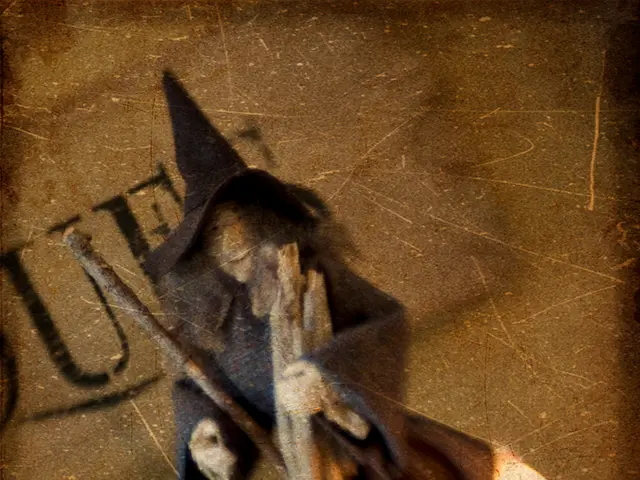"Evidence-based treatments keep individuals with gallbladder stones from undergoing avoidable medical procedures"
Rethinking the Gallbladder: Busting Myths and Uncovering Facts with a Gastroenterologist
Image source: Shutterstock
Struggling with digestive issues during holiday seasons or summer picnics? You might end up needing that gallbladder surgery more than you think! What are the real risks and symptoms? Let's dive into this complex organ, debunking myths and leveraging scientific insights with Dr. Alexei Paranov, a gastroenterologist, and expert in evidence-based medicine.
UNRAVELING THE PAIN IN YOUR RIGHT UPPER ABDOMEN
Dr. Alexei Paranov, are the reports of cholecystitis prevalence in nearly half the population true?
While it's common to diagnose cholecystitis, it's often misdiagnosed. Pain in the upper right abdomen is commonly due to nerve entrapment, muscle tension, or irritable bowel syndrome. Only approximately 0.5% of cases are related to gallbladder problems[4].
WHAT'S THE REAL DEAL WITH PAIN AFTER EATING?
Real cholecystitis is characterized by high fever, changes in blood tests [leukocytes increase, C-reactive protein (CRP) rises][2], and, uniquely, cramping pain occurring after eating, but brief[4].
Remarkable Incidents and Cholecystitis Odyssey
One of Dr. Paranov's patients experienced peculiar pain behind the sternum. Initially, she feared a heart attack, but an ultrasound and MRI revealed a gallstone that had passed through the duct and caused severe inflammation, highlighting the importance of considering gallbladder issues beyond typical symptoms[4].
CAUSES OF GALLSTONES AND CHOLECYSTITIS
What genetic factors contribute to gallstones and cholecystitis?
Gallstones often stem from genetic predisposition, resulting in fluid bile that promotes sediment and sludge accumulation[1][4]. A crystallization point is needed for stone formation, which can be facilitated by infection or dehydration[1][4].
DIETARY FATS AND GALLBLADDER HEALTH
Contrary to popular belief, fatty foods are choleretic, reducing the risk of sludge and stone formation. However, moderation is key to avoid gaining excess weight and associated gallstone disease risks[4]. On the flip side, an unbalanced diet, like the 5th dietary table, deprives the gallbladder of the necessary contraction stimuli, increasing sludge formation risks[4].
OVEREATING AND HOLIDAY FEARS
Overindulgence is dangerous for those with gallstones. Consuming large amounts of fatty food or alcohol can cause severe gallbladder contractions, potentially triggering stone movement, leading to acute inflammation[4].
The bottom line? Maintain a generally healthy lifestyle to promote gallbladder health[4].
SURGERY: TO HAVE OR NOT TO HAVE?
Modern medicine acknowledges that gallstones do not always necessitate surgery, and many people can live comfortably with them without limiting their diet[4]. Surgery is typically recommended for [biliary pain, severe and sudden pain (biliary colic)], and the presence of a stone larger than 3 cm][2][4].
GALLSTONE SOLUTIONS: CRUSH OR REMOVE?
Gallstone fragmentation (lithotripsy) is no longer considered a viable treatment option due to unsuccessful results[4]. Lithotripsy remains relevant when stones move into the common bile duct, requiring medical intervention to remove the fragments and then performing laparoscopic gallbladder removal[4].
DIAGNOSIS: HOW TO CHECK?
Ultrasound is the gold standard for diagnosing gallbladder conditions, while CT or MRI may be used in specific cases [when complications have begun or to determine if stones are dissolvable][4][5].
THE TRUTH ABOUT PREVENTION: DRIVE BILE OR JUST EAT?
Overprescription of ursodeoxycholic acid is common, often for benign cases like a bend in the gallbladder. Regular consumption of choleretic agents like immortelle, milk thistle, and corn stigmas is not recommended if you have gallstones, as it can trigger stone movement and lead to surgery[4]. For those without stones, a balanced diet with sufficient fat intake is sufficient[4].
Tubage, a self-proclaimed cleansing remedy, should be avoided as it poses risks up to pancreatitis[4].
In conclusion, know your risks, eat wisely, and consult with medical professionals to maintain a healthy gallbladder!
[1] Gallstones: a review[2] Treatment of Cholecystitis[3] Symptoms of Cholecystitis[4] Interview with Dr. Alexei Paranov about Gallbladder Health[5] Guide to Gallbladder Imaging
- Dr. Alexei Paranov clarifies that the reports of cholecystitis prevalence in nearly half the population are often misdiagnosed.
- Pain in the upper right abdomen is commonly due to nerve entrapment, muscle tension, or irritable bowel syndrome, not gallbladder problems in most cases.
- Real cholecystitis is characterized by high fever, changes in blood tests, and cramping pain occurring after eating, but brief.
- A peculiar case of Dr. Paranov's patient experienced pain behind the sternum, initially feared a heart attack, but it was caused by a gallstone.
- Gallstones often stem from genetic predisposition that results in fluid bile promoting sediment and sludge accumulation.
- A crystallization point is needed for gallstone formation, which can be facilitated by infection or dehydration.
- Contrary to popular belief, fatty foods are choleretic, reducing the risk of sludge and stone formation, but moderation is key to avoid gaining excess weight.
- An unbalanced diet like the 5th dietary table deprives the gallbladder of necessary contraction stimuli, increasing sludge formation risks.
- Overindulgence in fatty food or alcohol can cause severe gallbladder contractions potentially leading to acute inflammation.
- Maintain a generally healthy lifestyle to promote gallbladder health.
- Modern medicine acknowledges that gallstones do not always necessitate surgery, and many people can live comfortably with them without limiting their diet.
- Surgery is typically recommended for biliary pain, severe and sudden pain (biliary colic), and the presence of a stone larger than 3 cm.
- Gallstone fragmentation (lithotripsy) is no longer considered a viable treatment option.
- Lithotripsy remains relevant when stones move into the common bile duct, requiring medical intervention to remove the fragments and then performing laparoscopic gallbladder removal.
- Ultrasound is the gold standard for diagnosing gallbladder conditions, while CT or MRI may be used in specific cases.
- Overprescription of ursodeoxycholic acid is common, often for benign cases like bends in the gallbladder.
- Regular consumption of choleretic agents like immortelle, milk thistle, and corn stigmas is not recommended if you have gallstones.
- Tubage, a self-proclaimed cleansing remedy, should be avoided as it poses risks up to pancreatitis.
- Consult with medical professionals to maintain a healthy gallbladder.
- Know your risks, eat wisely, and maintain a healthy lifestyle for a healthy gallbladder.
- Chronic diseases such as type-2 diabetes and chronic kidney disease, along with mental health issues, are significant topics in workplace-wellness discussions.
- Education and regular check-ups are essential to identify early signs of medical conditions and manage them properly.
- Employers can provide on-site wellness programs, mental health resources, and resources on nutrition, weight management, and fitness-and-exercise.
- As part of a comprehensive healthcare approach, healthcare professionals can suggest therapeutic options like artificial intelligence-assisted medications and CBD for treating various conditions.
- In manufacturing, implementing environmental-science strategies reduces the environmental footprint and saves costs.
- Climate-change solutions in industries like transportations, retail, and energy industries contribute to a sustainable future by adopting renewable technologies and circular-economy practices.
- Mental health is equally important as physical health, with therapies-and-treatments options like mindfulness and cognitive-behavioral therapy available.
- By focusing on wellness in all aspects of personal and professional life, such as health-and-wellness, fitness-and-exercise, nutrition, and mental health, one can improve quality of life, productivity, and overall happiness.








